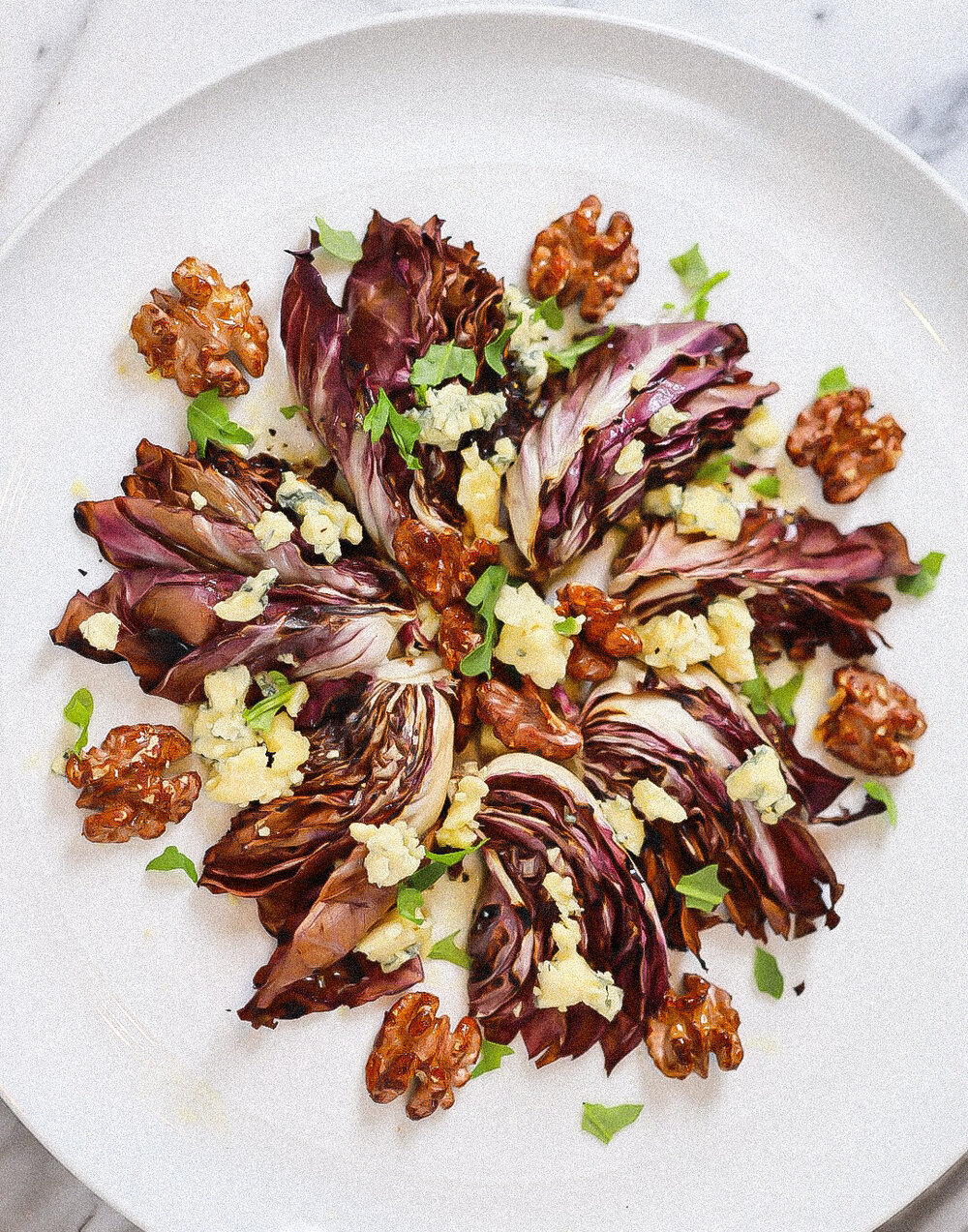Grilled Radicchio Salad with Blue Cheese and Candied Walnuts
This grilled radicchio salad is bursting with flavours and works wonderfully as a winter starter. I usually make this radicchio recipe with 'gorgonzola piccante' but I had an excess of English stilton after Christmas which works equally well.
The unassuming purple and white radicchio is high in fibre, low in calories, and a great source of potassium. I love raw spicy bitter radicchio in salads but radicchio truly shines when it is cooked. I roast, bbq, grill, and even stirfry radicchio. Griddling radicchio in this winter salad recipe will mellow it and bring out a sweet nutty aroma flavour that contrasts with the sharp blue cheese.
What is radicchio?
Often mistaken for red cabbage, radicchio is a type of chicory. It is popular in Italy, where it has been eaten since ancient times. Radicchio is a hardy vegetable and stores well in the fridge for a couple of weeks - just peel off the outermost layers before you use an older head.
Grilled Radicchio with Blue Cheese and Walnuts
Serves 2

Grilled Radicchio Salad with Blue Cheese and Candied Walnuts Salads
Ingredients
- 1 head of round radicchio (or 2 small radicchio treviso)
- 3.5oz of strong blue cheese, crumbled
- 12 walnuts
- 2 tablespoons honey
- Rocket leaves, to garnish
- 3 tablespoons olive oil
- 1 tablespoon lemon juice
- 1 teaspoon Dijon mustard
- Salt & Pepper
Instructions
Frequently asked Questions
How do you cook radicchio so it's not bitter?
Radicchio's bitterness can be mellowed through cooking. Grilling or roasting is a popular method, as it caramelizes the sugars and softens the texture. You can also sauté radicchio in olive oil with garlic and red pepper flakes. Another option is to braise it in broth or wine to soften the bitterness.
Can you eat radicchio raw in a salad?
Yes, radicchio can be eaten raw in salads. Its slightly bitter flavor adds a unique contrast to sweeter ingredients like apples or pears. However, if you find the bitterness too intense, you can soak the radicchio in cold water to reduce its bitterness.
What does radicchio pair well with?
Radicchio pairs well with a variety of flavors. Its slightly bitter taste complements the richness of blue cheese, Gorgonzola, or goat cheese. It also pairs well with salty, cured meats like prosciutto or salami. For a sweeter pairing, consider using honey or balsamic vinegar.
How do you clean radicchio for salad?
To clean radicchio, first, remove any outer leaves that are wilted or damaged. Then, cut the radicchio into wedges or smaller pieces. Rinse the radicchio under cold water to remove any dirt or debris. You can also soak the radicchio in a bowl of cold water to help reduce its bitterness.
Why do you soak radicchio in water?
Soaking radicchio in cold water can help to reduce its bitterness. The water helps to draw out some of the bitter compounds, making the vegetable more palatable. However, it's important not to soak the radicchio for too long, as this can lead to a loss of flavor and texture.
How do Italians eat radicchio?
Italians often use radicchio in a variety of dishes, both raw and cooked. It's commonly used in salads, pasta dishes, and as a pizza topping. In some regions, radicchio is grilled or roasted and served with olive oil, balsamic vinegar, and Parmesan cheese.
Is radicchio an anti-inflammatory?
Radicchio is a good source of antioxidants, which may have anti-inflammatory properties. However, more research is needed to fully understand the extent of its anti-inflammatory effects.
Why is radicchio so expensive?
Radicchio can be more expensive than other leafy greens due to its limited growing season and specific cultivation requirements. It's a delicate vegetable that requires careful handling and storage. Additionally, the unique flavor and nutritional profile of radicchio contribute to its higher price point.
What is the best way to eat radicchio?
The best way to eat radicchio depends on your personal preference. Some people prefer it raw in salads, while others prefer it cooked. Grilling, roasting, or sautéing can help to mellow the bitterness and bring out the vegetable's natural sweetness.
How to cut radicchio for salad?
To cut radicchio for salad, first, remove any outer leaves that are wilted or damaged. Then, cut the radicchio in half lengthwise and remove the core. You can then slice the radicchio into thin wedges or chop it into bite-sized pieces.
How long will radicchio last in the refrigerator?
Radicchio can last in the refrigerator for up to a week when stored properly. Wrap the radicchio in a plastic bag and store it in the crisper drawer of your refrigerator. To extend its shelf life, avoid washing the radicchio until you're ready to use it.
Is radicchio a lettuce or cabbage?
Radicchio is a type of chicory, which is a leafy green vegetable related to lettuce and endive. However, it has a more bitter flavor and a denser texture than most lettuces.
How to get the bitterness out of radicchio?
To reduce the bitterness of radicchio, you can soak it in cold water for 10-15 minutes. You can also cook the radicchio to mellow its flavor. Grilling, roasting, or sautéing are effective methods for reducing bitterness. Additionally, pairing radicchio with other flavors, such as sweet fruits or creamy dressings, can help to balance the bitterness.
Why do people eat radicchio?
Radicchio is a nutritious vegetable that is rich in vitamins, minerals, and antioxidants. It's also low in calories and high in fiber. Beyond its nutritional benefits, radicchio adds a unique flavor and texture to salads, pasta dishes, and other recipes.


